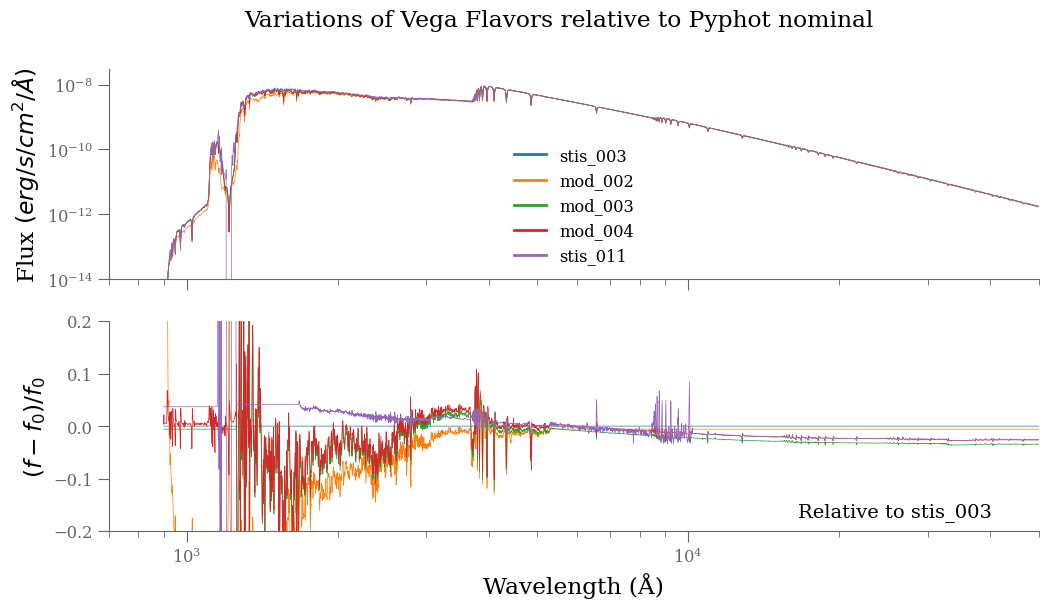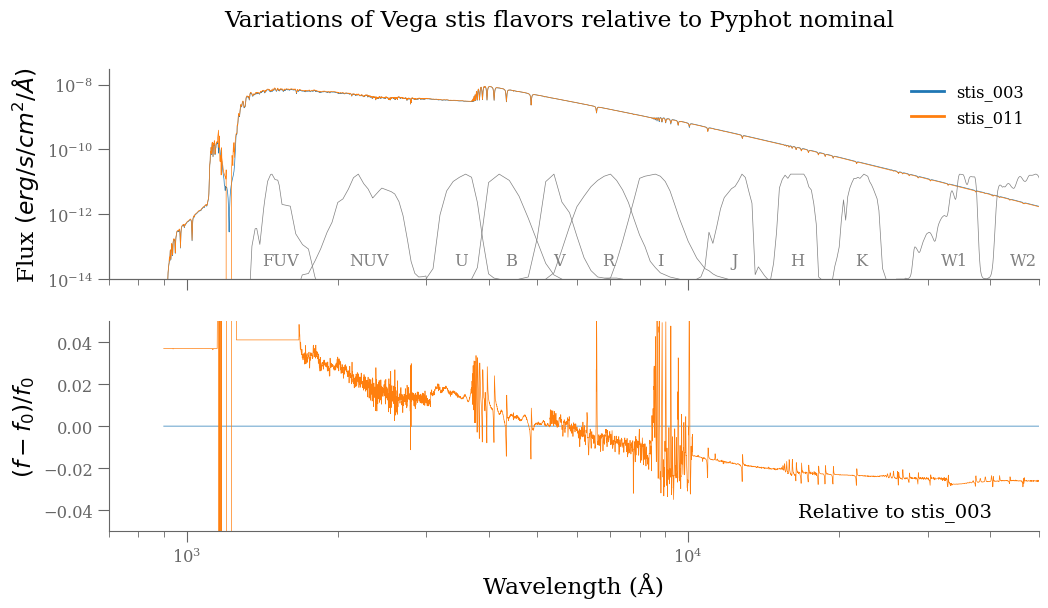Internal Vega reference spectra#
Summary#
Often in photometry, a spectrum of reference for Vega is necessary.
By default, we use the synthetic spectrum alpha_lyr_stis_003 provided by Bohlin 2007, a common reference througout many photometric suites.
The interface to the Vega template is given through the pyphot.vega.Vega class.
To use a specific Vega flavor for the photometric calculations in Pyphot, you can set the vega keyword parameter when creating a passband or use the set_vega_flavor method to update it.
Details#
Vega (aka \(\alpha\) Lyrae, HD 172167) serves as the fundamental calibration standard for stellar photometry due to its exceptional brightness, and favorable observational characteristics. It is the fifth brightest star in the sky, after Sirius, Canopus, Alpha Centauri and Arcturus and the second brightest star in the northern celestial hemisphere. As a nearby A0V star located approximately 25 light-years from Earth, Vega was historically chosen as the primary standard because of its position near the north celestial pole, making it easily accessible to northern hemisphere observatories year-round (Johnson & Morgan 1953).
Vega is a Delta Scuti variable star (dwarf Cepheids), one whose variations in luminosity result from both radial and non-radial pulsations of its surface. Some parts of its surface contract while others simultaneously expand (non-radial pulsations), and the star also contracts and expands by changing its radius to maintain its spherical shape (radial pulsations). Delta Scuti variables are commonly used as standard candles to establish distances because of their relatively flat spectral energy distribution across optical wavelengths and “stability” over decades make it an ideal reference for establishing magnitude zero-points across multiple filter systems (Oke & Gunn 1983).
However, the fact that Vega is actually a variable star with small but measurable brightness variations has led the astronomical community to adopt more stable references. The International Astronomical Union (IAU) and major observatories now commonly use synthetic standards based on theoretical stellar atmosphere models or carefully selected ensembles of stable stars. These synthetic standards provide consistent, reproducible reference points that are not subject to the intrinsic variability observed in individual stars like Vega, ensuring long-term stability in photometric calibrations across different observatories and epochs.
Modern space-based observations have refined Vega’s spectral energy distribution to unprecedented precision, with the CALSPEC database providing the definitive reference spectrum used by HST and other major observatories (Bohlin et al. 2014). Despite the discovery of Vega’s infrared excess due to a circumstellar debris disk and minor photometric variability, it remains the cornerstone of photometric systems, with the AB magnitude system providing an alternative that maintains compatibility while addressing some of Vega’s limitations (Fukugita et al. 1996).
Vega Flavors#
Important
Since version 1.7.0, Pyphot includes a set of Vega flavors one can use transparently as photometric standards.
Pyphot provides alpha_stis_003 (aliased to legacy) as the default Vega flavor (and only one before version 1.7.0). This flavor is also the reference for the values provided in the documentation.
(since version 1.7.0) Pyphot provides also alpha_lyr_mod_003, alpha_lyr_mod_004, and alpha_stis_011 as alternative Vega flavors.
in a future release, Pyphot will switch the default Vega flavor to alpha_stis_011 which is a more recent model that incorporates updated NLTE models and provides a more accurate representation of Vega’s spectral energy distribution, particularly in the ultraviolet and optical ranges.
Impact of Vega Flavors on zeropoints provided by Pyphot:
Changes in temperature will introduce a wavelength dependent shift in the vega zero points.
Changes in logg, metallicity, turbulence will introduce non trivial variations in the vega zero points.
CALSPEC provides a collection of composite stellar spectra that are flux standards for the calibration of systems such as HST. In particular, it compiles many flavors of Vega of which we summarize the most relevant ones below:
alpha_lyr_004 from Bohlin, Colina, & Finley (1995). It corrsponds to pure hydrogen white dwarf models are the absolute flux standards.
alpha_lyr_005 from Colina, Bohlin & Castelli (1996), Instrument Science Report (OSG-CAL-96-01). It corresponds to the combination of ultraviolet covered by average IUE spectrum; Optical up to 1.05 microns covered by Hayes (1985) average spectrum (IAU Symp 111, p 225); near-infrared covered by ATLAS12 based model computed by Dr. Castelli, rebinned to 25A, and normalized to Hayes (1985) Johnson V flux. V filter as in Buser & Kurucz 1979, AA 70, 555. (All wavelengths are vacuum.)
alpha_lyr_stis_003 (legacy) from Bohlin (2007) a special model from Kurucz 9400K Vega spectrum T/g=9400/3.9 [M/H]=-0.5 fit against STIS data with microturbulence of 0. km/s, and where V = 0.023 mag.
alpha_lyr_mod_001 from Bohlin (2014) Special Model from Kurucz 9400K Vega spectrum T/g=9400/3.9 [M/H]=-0.5 at R=500 which reconciles visible and IR absolute flux, and where Vega Flux(5556A)=3.44e-9
alpha_lyr_mod_002 is identical to alpha_mod_001 but normalized to STIS flux at 5545-5570A, corresponding to a scaled flux by 0.994242.
alpha_lyr_mod_003 is a different temperature, logg using Kurucz 9550K Vega spectrum T/g=9550/3.95 [M/H]=-0.5 at R=500 and normalized to Flux(5556A) = 3.44e-9 (over 5545-5570A).
alpha_lyr_mod_004 from Bohlin, Hubeny, Rauch (2020) is similar to alpha_mod_003 but with a Flux(5556A)=3.47e-9. In the details, it also includes additional lines.
alpha_lyr_stis_011 is a special model from Bohlin which is a composite flux of a special Kurucz 9550K model from 900-1152A (Kurucz 2003), IUE data from 1152-1675A, STIS CCD fluxes from 1675-10200A (Bohlin & Gilliland 2004a), and the 9550K model longward of 10200A. It differs significantly in the uv-optical range by accounting for the new TMAP AND TLUSTY WD NLTE models (Bohlin, Hubeny, Rauch (2020)) but corresponds to alpha_mod_004 above 1 micron.
The figure below shows the differences between the various Vega flavors available in Pyphot. The top panel shows the absolute fluxes, while the bottom panel shows the relative differences with respect to the alpha_stis_003 (the legacy Pyphot reference flavor). flavor.

Figure: Variations of Vega Flavors relative to Pyphot legacy reference flavor (alpha_stis_003). The differences between the various flavors could be significant, particularly in the ultraviolet. These result from stellar template parameter changes (e.g. temperature), the reference atmospheres (e.g. LTE, NLTE) and specific calibration details.#
Figure source code
import numpy as np
import matplotlib.pyplot as plt
from pyphot import Vega
def plot_vega_comparison(which):
_, axes = plt.subplots(2, 1, figsize=(12, 6), sharex=True)
# Use the first as reference
with Vega(flavor=which[0]) as vega:
vega_reference = vega
# Plot each flavor and the relative difference to the reference
for flavor in which:
with Vega(flavor=flavor) as vega:
axes[0].loglog(
vega.wavelength.magnitude, vega.flux.magnitude, label=flavor, lw=0.5
) # type: ignore
fref = np.interp(
vega.wavelength.magnitude,
vega_reference.wavelength.magnitude,
vega_reference.flux.magnitude,
) # type: ignore
axes[1].plot(
vega.wavelength.magnitude,
(vega.flux.magnitude - fref) / fref,
label=flavor,
lw=0.5,
) # type: ignore
# polish
axes[1].set_ylim(-0.20, 0.20)
axes[0].set_ylim(1e-14, 3e-8)
axes[0].set_ylabel(r"Flux $(erg/s/cm^2/Å)$")
axes[1].set_ylabel(r"$(f - f_0) / f_0$")
axes[1].text(
0.95,
0.05,
f"Relative to {which[0]}",
transform=axes[1].transAxes,
ha="right",
va="bottom",
)
axes[1].set_xlabel("Wavelength (Å)")
axes[0].set_xlim(700, 50_000)
lg = axes[0].legend(loc="best", fontsize="small", frameon=False)
plt.setp(lg.get_lines(), lw=2);
which = ["stis_003", "mod_002", "mod_003", "mod_004", "stis_011"]
plot_vega_comparison(which)
plt.suptitle("Variations of Vega Flavors relative to Pyphot nominal", fontsize="large")
The following figure compares the alpha_stis_003 and alpha_stis_011 flavors, which are the two most commonly used Vega flavors in Pyphot. The alpha_stis_011 flavor is a more recent model that incorporates updated NLTE models and provides a more accurate representation of Vega’s spectral energy distribution, particularly in the ultraviolet and optical ranges.

Figure: Variations of Vega STIS Flavors. The variations are of the order of 5% in the optical, primarily induced by the update in temperature.#
Figure source code
from pyphot import svo
# filters to add for reference
pbs = [
svo.get_pyphot_filter(name)
for name in [
"GALEX/GALEX.FUV", "GALEX/GALEX.NUV",
"Generic/Johnson.U", "Generic/Johnson.B", "Generic/Johnson.V", "Generic/Johnson.R", "Generic/Johnson.I",
"Generic/Bessell_JHKLM.J", "Generic/Bessell_JHKLM.H", "Generic/Bessell_JHKLM.K",
"WISE/WISE.W1", "WISE/WISE.W2",
]
]
which = ["stis_003", "stis_011"]
plot_vega_comparison(which)
plt.suptitle(
"Variations of Vega stis flavors relative to Pyphot nominal", fontsize="large"
)
axes = plt.gcf().get_axes()
# add passbands
ax1 = plt.twinx(axes[0])
for p in pbs:
ax1.plot(
p.wavelength.to("AA").magnitude,
p.transmit / p.transmit.max(),
label=p.name, lw=0.5, color="0.5",
)
ax1.text(
p.cl.to("AA").magnitude,
0.1,
p.name.split(".")[-1],
ha="center", va="bottom", fontsize="small", color="0.5",
)
ax1.set_ylim(0, 2.0)
plt.setp([ax1.get_yticklabels(), ax1.get_yticklines()], visible=False)
Note
We note that alpha_stis_011 seems to be corrupt around 1200 Å which has no impact of currently existing passbands.
Example Vega Flavors Usage#
To use a specific Vega flavor for the photometric calculations in Pyphot, you can set the vega keyword parameter when creating a passband or use the set_vega_flavor method to update it. For example, to use the alpha_stis_011 flavor when creating a passband filter, you can do the following:
from pyphot import Filter
import astropy.units as u
# Create a passband using the Vega flavor
pb = Filter(
[4000, 5000, 6000] * u.AA,
[0.1, 0.8, 0.1],
name="Example Passband",
dtype="photon"
vega="stis_011" # Specify the Vega flavor,
)
Or alternatively, you can set/reset the Vega flavor after:
from pyphot import svo
pb = svo.get_pyphot_filter("GALEX/GALEX.FUV")
# Set the Vega flavor to use
pb.set_vega_flavor("stis_011")
References#
Bohlin, R. C., Colina, L., & Finley, D. S., 1995, AJ, 110, 1316, “White Dwarf Standard Stars: G191-B2B, GD 71, GD 153, HZ 43”, 1995AJ….110.1316B
Bohlin, R. C., 2007, ASPC, 364, 315, “HST Stellar Standards with 1% Accuracy in Absolute Flux”, 2007ASPC..364..315B
Bohlin, R. C., 2014, AJ, 147, 127, “Hubble Space Telescope CALSPEC Flux Standards: Sirius (and Vega)”, 2014AJ….147..127B
Bohlin, R. C., Gordon, K. D., & Tremblay, P.-E., 2014, PASP, 126, 711, “Techniques and Review of Absolute Flux Calibration from the Ultraviolet to the Mid-Infrared”, 2014PASP..126..711B
Bohlin, R. C., Hubeny, I., & Rauch, T., 2020, AJ, 160, 21, “New Grids of Pure-hydrogen White Dwarf NLTE Model Atmospheres and the HST/STIS Flux Calibration”, 2020AJ….160…21B
Colina, Bohlin & Castelli 1996, Instrument Science Report, “Absolute Flux Calibrated Spectrum of Vega” OSG-CAL-96-01
Fukugita, M., Ichikawa, T., Gunn, J. E., Doi, M., Shimasaku, K., & Schneider, D. P., 1996, AJ, 111, 1748, “The Sloan Digital Sky Survey Photometric System”, 1996AJ….111.1748F
Johnson, H. L. & Morgan, W. W. 1953, ApJ, 117, 313, “Fundamental stellar photometry for standards of spectral type on the Revised System of the Yerkes Spectral Atlas.” 1953ApJ…117..313J;
Oke, J. B. and Gunn, J. E., 1983, ApJ, 266, 713, “Secondary standard stars for absolute spectrophotometry.” 1983ApJ…266..713O;